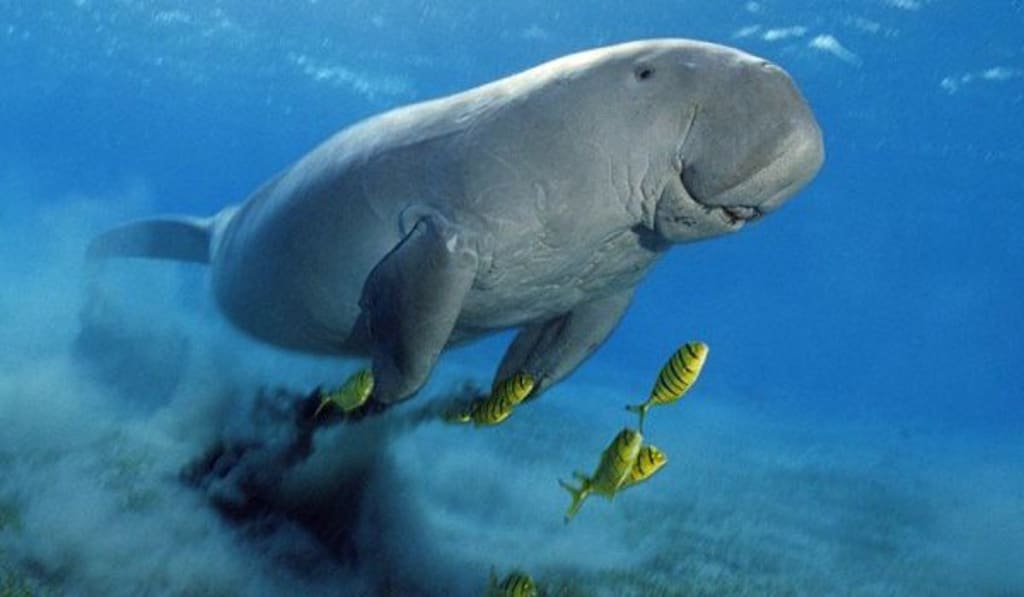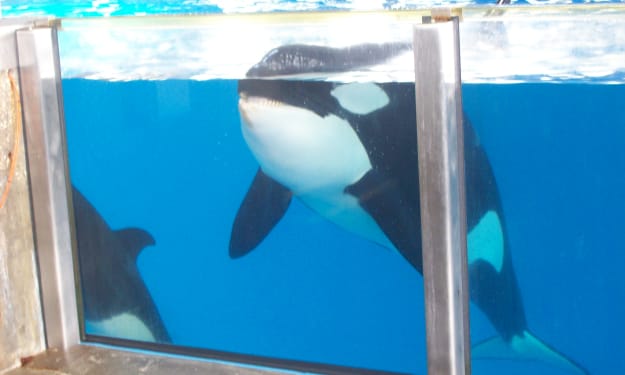Six Facts About Dugongs
Get to know the cousin of the manatee, which is known to some as the “sea cow,” and “sea pig.”

Dugongs, while similar to manatees, are shorter and slender comparing to their western hemisphere well-known marine mammals to have ever been studied in the Southern Hemisphere, research that has been done on the animals would eventually give way to the rise of manatee research in the United States and Brazil. These animals are known to grow up to 11 feet long and weight up to 2,200 pounds.
1. They have tusks.
Unlike other living sirenians, dugongs possess tusks. Although all animals of both genders do have tusks, they are only visible in the skin of mature males, in which the tusks are more prominent, and in older females. While it’s believed that males may use the tusks to fight each other for the right to mate, researchers now believe that dugongs use them for foraging off a variety of seagrasses. The tusks enable the animals to manipulate their food towards their mouths with large prehensile rostral disks. The tusks will start to develop when the animals are around 12-15 years of age. It’s a common characteristic trait that they share with their land-bound relative, the elephant.
2. They are social animals.
Unlike manatees, which are known to be solitary in nature, except for mother-and-calf pairs, dugongs are known to be social animals. They are commonly known to form small groups of up to six animals, but on multiple occasions, they have been known to form groups of several hundred. However, the function of these groups is not well understood.
3. They are called “sea cows” for a reason.
As herbivores, dugongs feed exclusively on marine vegetation, which consists of leaves, roots, and of course sea grasses. Yet, the reason why they are called “sea cows” is because dugongs are known to be marine grazers that forage on bottom vegetation while leaving trails of newly cropped plants that can be seen during low tides when seagrasses meadows are exposed. While they are known to feed anytime of the day, in places where human disturbance is common, they will often feed during the night hours.
4. The Red Sea population may have a Mediterranean origin.
Recent studies done on fossilized remains of extinct populations have confirmed that Dugongs were once found in the Mediterranean Sea. In addition, it’s also where the species was believed to have first evolved during the mid to late Eocene Epoch. In fact, they were present in that region up until the late Miocene when the climate began to get cooler, which would eventually lead to the Ice Age. Since the Red Sea was once connected to the Mediterranean during that time, it’s believed that it’s Dugong population might have some ancestral ties to the now extinct Mediterranean population.
5. They have lower reproductive potential than manatees.
According to research done on wild populations in Australia, female dugongs do not reach sexual maturity until they are 18 years of age. However, the youngest animal to have ever been known to give birth was around ten years of age. The gestation period is around 12-14 months with calves being around three feet long and weighting in at around 55 pounds. Mothers will go to shallow waters to give birth to their calves with weaning occurring at around 18 months of age. Yet, dugong calves will stay with their mothers for several years, which can explain why mother dugongs may have a new calf every two to seven years.
6. They are vulnerable.
As a vulnerable species, dugongs are threatened by a verity of human activities that have had a huge impact on wild populations worldwide. While archaeological records in the Middle East confirmed that dugongs have been hunted for about 4,000 years, commercial hunting has caused their numbers to decline in some areas. The animals were usually hunted for their meat, which is sold in various parts of the South Pacific. In Australia, where Dugongs are protected by law, only aboriginal hunters are allowed to take a very few animals for traditional purposes. In addition to commercial hunting, habitat destruction has also caused wild populations to decline. For example, the habitat destruction of seagrasses along the Australian coast has been linked to dredging, land development, and land reclamation in the area. As a result, it makes it very difficult for the mammals to find food, which could then, lead to them to possibly starve to death. This can jeopardize the potential recovery for the species in Australia. Other threats include entanglement in fishing gear, pollution, and the effects of climate change.
Hope you got to know a little bit about this ancient inspiration for the mermaids of fairy tales and mythology and how important they are to the marine ecosystem.
About the Creator
Jenna Deedy
Zoo and Aquarium Professional, Educator, Cosplayer, Writer and B.A. in Psychology whose got a lot to share when it comes to animals, zoos, aquariums, conservation, and more.
Instagram: @jennacostadeedy







Comments
There are no comments for this story
Be the first to respond and start the conversation.